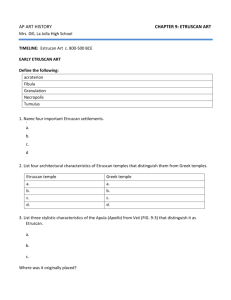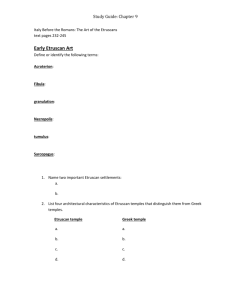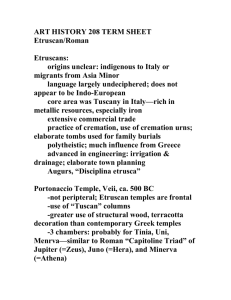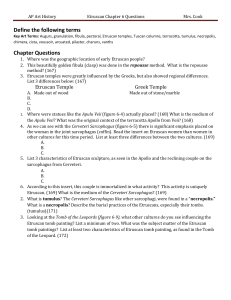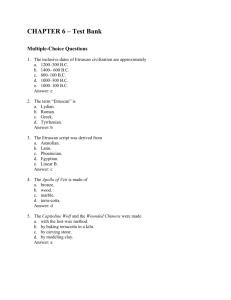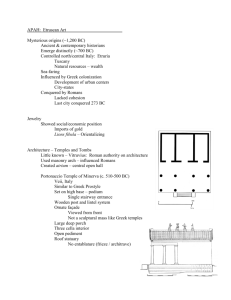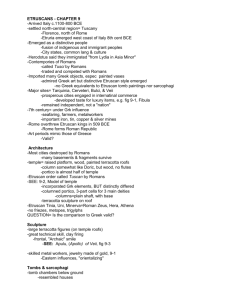discussion questions
advertisement
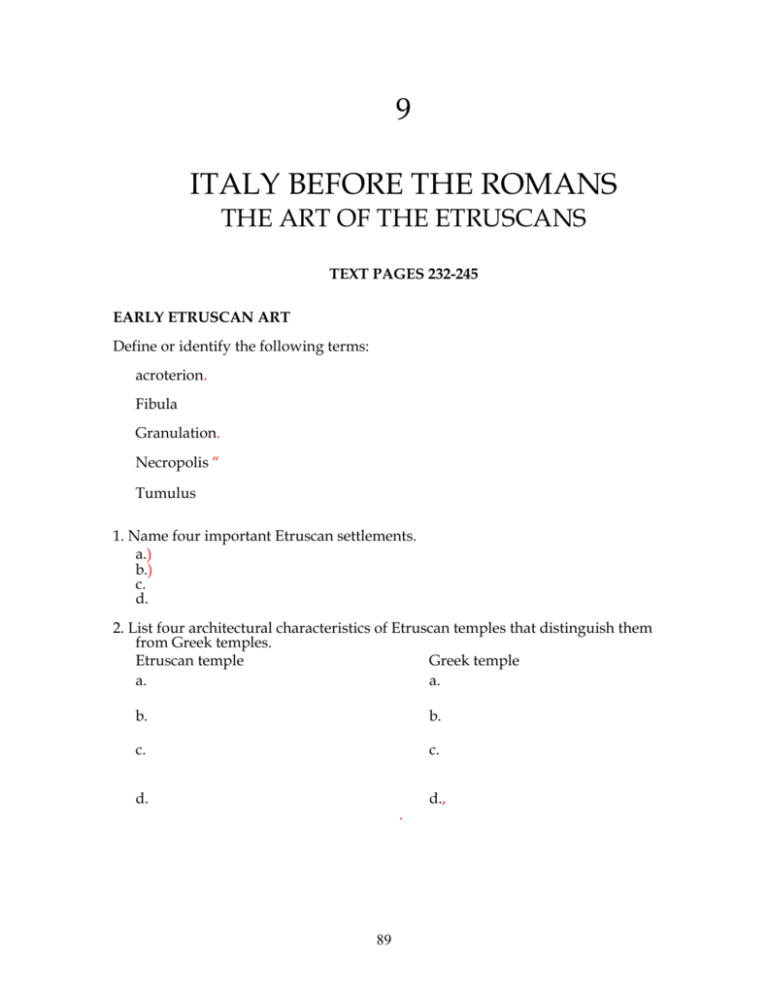
9 ITALY BEFORE THE ROMANS THE ART OF THE ETRUSCANS TEXT PAGES 232-245 EARLY ETRUSCAN ART Define or identify the following terms: acroterion. Fibula Granulation. Necropolis “ Tumulus 1. Name four important Etruscan settlements. a.) b.) c. d. 2. List four architectural characteristics of Etruscan temples that distinguish them from Greek temples. Etruscan temple Greek temple a. a. b. b. c. c. d. . 89 d., 3. List three stylistic characteristics of the Apula (Apollo) from Veii (FIG. 9-3) that distinguish it as Etruscan. a. b.. c.. Where was it originally placed? . 4. What were the favorite materials of Etruscan sculptors? LATER ETRUSCAN ART Define or identify the following terms and understand what they mean for understanding Etruscan art: arcuated gateway. Chimera. Cista Voussoir 1. Why is the Etruscan Capitoline Wolf (FIG. 9-10) so famous? 2. Describe the medium and technique used for decorating The Ficoroni Cist (FIG. 9-12). 3. In what way is the sarcophagus of Lars Pulena (FIG. 9-14) different from that of the reclining couple shown in FIG 9-4? How might the subject on the reliefs relate to the political situation of the Etruscans in the 2nd c BCE? 4. List two features of the magnificent bronze figure of Aule Matele (FIG. 9-15) that show the influence of the Romans. a. b. DISCUSSION QUESTIONS 1. Compare the Apulu (Apollo) from Veii (FIG. 9-3) with the Riace Warrior (FIG. 5-34). Explain how the typical Etruscan features of the former contrast with the typical Greek features of the latter. 2. How do the style, color, subject matter, and mood of an Etruscan fresco (FIG. 9-8) compare with those of a contemporary Greek vase painting (FIG. 5-56)? 90 3. In what way was the Etruscan rise and fall from power reflected in the decoration of their tombs? To what degree was it reflected in their bronze work? 4. Compare the Etruscan sarcophagus with the reclining couple on FIG. 9-4 and the fresco on FIG. 9-8 with the Egyptian funerary monument from Gizeh shown on 3-13 and the Greek funerary stele on 5-55. What do these monuments say about relationships between people in these societies as well as about their ideas toward death? 5. Do you think that Etruscan landscape paintings like the one on FIG. 9-9 are closer to Egyptian or Minoan paintings? Why? 6. What do art images tell us about the relative positions of Greek and Etruscan women? Select two examples from each culture to illustrate your argument. LOOKING CAREFULLY AND ANALYZING Describe the function of a fibula and then compare the Etruscan fibula on FIG. 9-1 with the Frankish fibula on FIG. 16-1. Even though you most likely will not have studied the Frankish fibula yet, it is interesting to compare the development of a certain item. Look very carefully at the two fibula and describe what you see. How do their shapes differ and how do the shapes relate to their function? What size are they? What materials and what techniques are used for each? Carefully describe the decorative forms and patterns used on each piece. How do they differ? How do the decorative forms relate to the underlying shapes? Try to imagine a fibula of each size on your shoulder and imagine in what circumstances they might have been worn. Which one do you prefer? Why? 91
